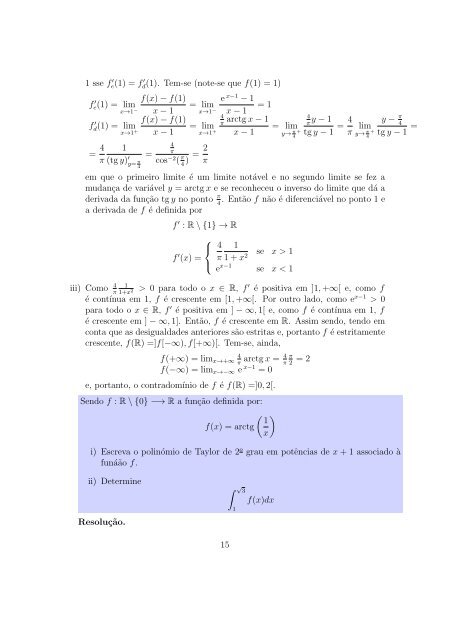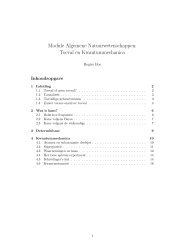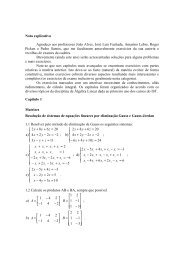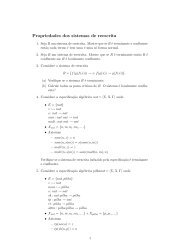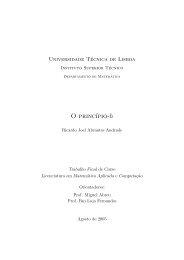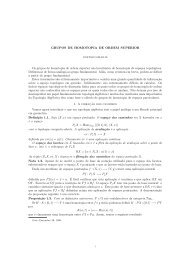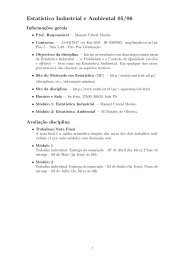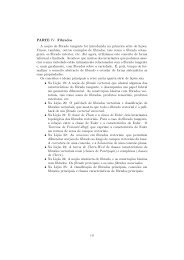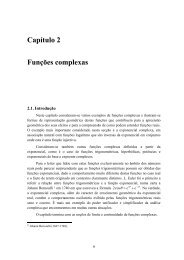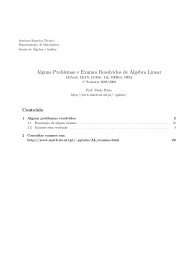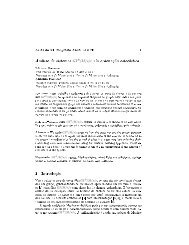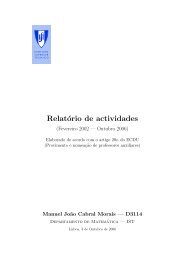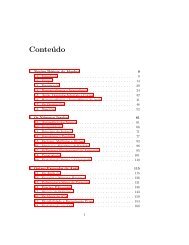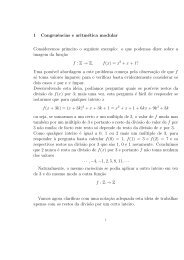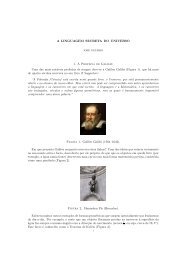Exercícios de Cálculo Integral e Diferencial I
Exercícios de Cálculo Integral e Diferencial I
Exercícios de Cálculo Integral e Diferencial I
Create successful ePaper yourself
Turn your PDF publications into a flip-book with our unique Google optimized e-Paper software.
1 sse f ′ e(1) = f ′ d (1). Tem-se (note-se que f(1) = 1)<br />
f ′ e(1) = lim<br />
x→1− f(x) − f(1)<br />
x − 1<br />
f ′ d (1) = lim<br />
x→1 +<br />
= 4<br />
π<br />
1<br />
(tg y) ′ y= π<br />
4<br />
f(x) − f(1)<br />
x − 1<br />
=<br />
4<br />
π<br />
cos −2 ( π<br />
4<br />
= lim<br />
x→1 −<br />
= lim<br />
x→1 +<br />
) = 2<br />
π<br />
e x−1 − 1<br />
= 1<br />
x − 1<br />
4 arctg x − 1<br />
π = lim<br />
x − 1<br />
y→ π<br />
4<br />
+<br />
4 y − 1 π<br />
tg y − 1<br />
4<br />
=<br />
π lim<br />
y→ π +<br />
4<br />
em que o primeiro limite é um limite notável e no segundo limite se fez a<br />
mudança <strong>de</strong> variável y = arctg x e se reconheceu o inverso do limite que dá a<br />
<strong>de</strong>rivada da função tg y no ponto π.<br />
Então f não é diferenciável no ponto 1 e<br />
4<br />
a <strong>de</strong>rivada <strong>de</strong> f é <strong>de</strong>finida por<br />
f ′ : R \ {1} → R<br />
f ′ ⎧<br />
⎨ 4 1<br />
(x) = π 1 + x<br />
⎩<br />
2 se x > 1<br />
e x−1<br />
se x < 1<br />
iii) Como 4 1<br />
π 1+x2 > 0 para todo o x ∈ R, f ′ é positiva em ]1, +∞[ e, como f<br />
é contínua em 1, f é crescente em [1, +∞[. Por outro lado, como ex−1 > 0<br />
para todo o x ∈ R, f ′ é positiva em ] − ∞, 1[ e, como f é contínua em 1, f<br />
é crescente em ] − ∞, 1]. Então, f é crescente em R. Assim sendo, tendo em<br />
conta que as <strong>de</strong>sigualda<strong>de</strong>s anteriores são estritas e, portanto f é estritamente<br />
crescente, f(R) =]f[−∞), f[+∞)[. Tem-se, ainda,<br />
arctg x = 4<br />
f(+∞) = limx→+∞ 4<br />
π<br />
f(−∞) = limx→−∞ e x−1 = 0<br />
e, portanto, o contradomínio <strong>de</strong> f é f(R) =]0, 2[.<br />
Sendo f : R \ {0} −→ R a função <strong>de</strong>finida por:<br />
<br />
1<br />
f(x) = arctg<br />
x<br />
π<br />
π<br />
2<br />
= 2<br />
y − π<br />
4<br />
tg y − 1 =<br />
i) Escreva o polinómio <strong>de</strong> Taylor <strong>de</strong> 2 o grau em potências <strong>de</strong> x + 1 associado à<br />
funáão f.<br />
ii) Determine<br />
Resolução.<br />
15<br />
√ 3<br />
1<br />
f(x)dx


